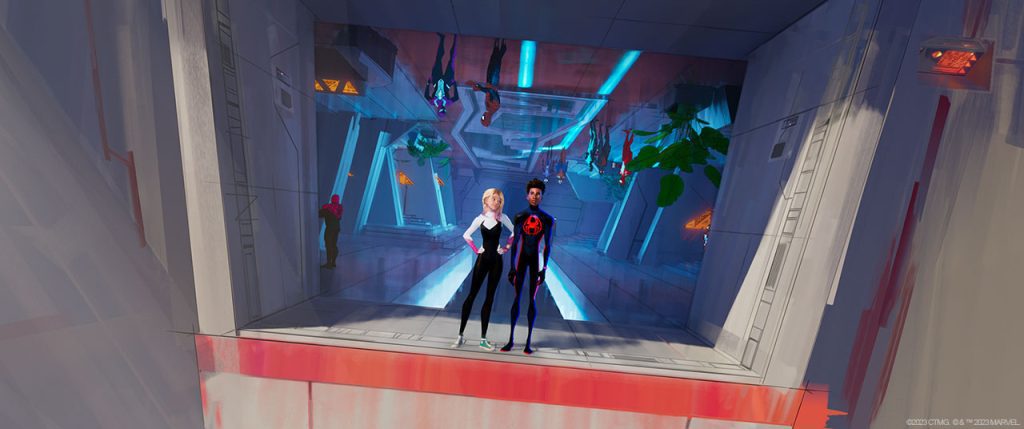Spider-Man: Into the Spider-Verse was a near perfect film that captured audiences in its web and put Sony Pictures Animation on the map with its gorgeous visuals. With Jordan-sized shoes to fill, expectations for the sequel couldn’t be higher. Simply put, Spider-Man: Across the Spider-Verse delivers. From the detailed visuals to its captivating story, the animated film is stunning in every verse. The stakes are higher, the animation style is more varied, everything is bigger in the sequel and not once does it falter under its own weight. Spider-Man: Across the Spider-Verse is comic book perfection.
It’s been a year since teenager Miles Morales was bitten by a radioactive spider and given powers and he is still adjusting to his new life as both a student and superhero. It doesn’t help that his closest friends, Gwen and Peter B. Parker, are back in other dimensions. Just as Miles has never felt more alone, an interdimensional portal opens up and Gwen appears. She’s now a part of the Spider-Society, a group of Spider-Men from across all Spider-Verses who protect the entire multiverse. The Spot, a villain-of-the-week from Miles’ universe, has become a little bit too powerful and threatens to tear all universes apart. Miles is eager to reunited with his friends and join the Spider-Society, but he soon learns the true cost of being Spider-Man and what it takes to put on the mask.
Into the Spider-Verse was groundbreaking in its animation, and Sony Pictures Animation does it again with Across the Spider-Verse. Every universe has its own unique animation style. Audiences are already familiar with the dot and line technique from Miles’ universe, and we now see that get expanded on in every direction. Gwen’s universe is painted with blotches of color that bleed through the lines. Early on in the film she fights a Vulture from the Renaissance universe. He sticks out like a sketch from Leonardo da Vinci, literally. Every character and universe has its own unique style that borrows elements based on their personality. Spider-Society member Spider-Punk is a rebel and British rocker. His animation is comprised of graffiti art and grunge stickers.

It can be a little chaotic with so many different art styles mixing and mashing together, but everything has its purpose. Gwen’s emotional state is captured by her animation style. In the beginning, she is sad and feels alone, just like Miles. Her face is covered in shades of blue and purple. At one point she hugs her dad and the screen is instantly filled with vibrant oranges, yellows, and reds that emanate from their embrace and push away the other colors. Miguel O’Hara, the leader of the Spider-Society, is comprised of mostly sharp lines and has a buzzing aura about him, evidence pointing towards his more serious approach to saving the multiverse. The animation is just as important to the story as anything else. It adds an extra layer of depth and allows creativity in scenes that would otherwise be impossible. It can be a bit much at first. There is a lot happening on screen all at once. But it’s an organized chaos where every frame has purpose. There truly is nothing else like it.
Admittedly I was initially worried about seeing another comic book film that tackles the multiverse. With both Marvel Studios and DC Studios expanding to other universes, it’s all grown a little tiresome over the years. Spider-Man: Across the Spider-Verse is the best of them all. The film brings in dozen of Spider-Men from the entire catalogue of Marvel comics and beyond. There is plenty of fan service in the film, and I won’t spoil any of the surprises, but prepared to be blown away. What makes it all work, however, is the fact that the film never gets away from its core; Miles. He is the driving force behind the film. Miles feels alone and abandoned and believes the Spider-Society can fill that hole. But when their actions force him to change his core identity, he begins to question their motives. Every version of Spider-Man has gone through the same trauma. It’s what makes them Spider-Man. And yet they all have their own unique identities in part to the little differences between universes. Across the Spider-Verse is all about exploring Miles’ identity. It’s that emotional core that carries the film. As wild, silly, and outrageous it can be at times, it always finds it way back.
Spider-Man: Across the Spider-Verse is one of the best films of the year, period. This is how a sequel should be. Everything is bigger. Everything is better. There is so much to take in. You’re going to miss things on the first viewing, but don’t worry, you’re going to want to see it again immediately after the credits start rolling. Sony Pictures Animation knocks it out of the park again with stunning visuals and an engaging story that comes together in one of the most ambitious and groundbreaking films I’ve seen on the big screen in a long time. The only complaint I have is that we now have to wait until next year for Spider-Man: Beyond the Spider-Verse. Thankfully we have two phenomenal Spider-Verse films to keep us occupied until then.
-
Spider-Man: Across the Spider-Verse
Summary
Spider-Man: Across the Spider-Verse delivers. From the detailed visuals to its captivating story, the animated film is stunning in every verse. The stakes are higher, the animation style is more varied, everything is bigger in the sequel and not once does it falter under its own weight. Spider-Man: Across the Spider-Verse is comic book perfection.







